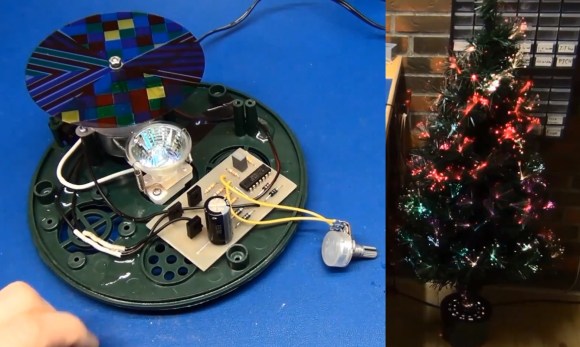What good is a fiber optic self-lighting Christmas tree if it flashes so fast it will put you into an epileptic attack? The answer is “Not very good”, if you ask [Mads Nielsen] a.k.a [EcProjects]. So [EcProjects ] started a little project to slow the Christmas tree’s blinkyness down to a more reasonable rate. The task didn’t seem too difficult at first but turned into a quality tutorial building a variable frequency H-bridge motor control.
After opening the base of the tree [EcProjects] found a 12 volt AC geared synchronous motor turning a multi colored translucent plastic disk. A bright spotlight was shining upwards through the turning disk into the ends of hundreds of small fiber optics. This mechanism dumps loads of multi colored light out the ends of the fibers at the tips of the Christmas tree branches as the disk turns.
His goal was to slow down the motor; however, the rotation was based on the 50 Hz mains signal. In order to continue using this motor a lower frequency AC power source was needed. What follows in the video is an excellent lesson on how an AC synchronous motor works plus how to build a variable frequency control and H-bridge using some transistors, resistors and CMOS 4069 inverter chip.
In the end the frequency drive could only be lowered to about 30 Hz before the synchronous motor would stall and reverse using his design. [EcProjects] was bold enough to include several fails which always provides more opportunity for learning and is greatly appreciated.
If you believe you have a better solution please share your idea in the comments. I’m sure the first proposal will include an Arduino and servo modified for continuous rotation, but any solutions would be fascinating including modifications to his design. You can join us after the break to watch the video.
Continue reading “Hacking A Christmas Tree For Less Blinkyness”











